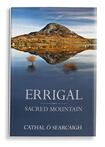
The poet Cathal Ó Searcaigh has long held a hypnotic fascination for Errigal mountain, Donegal’s glinting quartzite peak, which at 2,466ft, is the county’s highest point. From his home at Mín an Leá, near Dunlewey, he contemplates the mountain – an isolated nunatak – that stood above glaciers during the ice ages.
Ó Searcaigh’s descriptive prose melds walking, reminiscence and reflection alongside neighbourly friendships while invoking writers such as the poet Seán Ó Ríordáin, Sean Dorman and Derek Jarman. He is inspired by the work of artists and musicians, and in particular the American photographer Rachel Giese- Brown’s Donegal images, and the work of Dutch photographer Jan Voster.
Ceaselessly surprised by the diversity of Errigal, the author is emotionally uplifted and appreciative of the revelatory power of silence, broken only by small sound sensations. He attunes himself to the deep humming of bees in the heather, the “whispering fraternity” of mosses in the boglands, murmuring water as well as shape-shifting colours and scudding clouds. The cackle of a startled moorhen or the waft of bog myrtle in Prochlais provides sensory background while the mountain remains steadfast, reassuring and imperturbable.
“Errigal,” the author declares, “whether it’s wrapped in a cashmere of cloud or wearing a shimmering negligee of snow is forever a witnessing presence to our fleeting lives.” Fresh collective nouns are minted: a benediction of skylarks, a Persian carpet of heathers, sedges, rushes and lichens; he hears in his garden an assembly of a “Dáil of warblers” and a “Senate of grasshoppers” whose governance is clear and lucid, a green supremacy of song. A selection of his dual-language poems is interspersed between the essayistic chapters, but the Irish language is in decline, which he sees as the most challenging cultural issue facing local people.
‘There are times I regret having kids. They’re adults, and it’s now that I’m regretting it, which seems strange’
Cillian Murphy: ‘You had the Kerry babies, the moving statues, no abortion, no divorce. It was like the dark ages’
The Dublin couple who built their house in a week
John Creedon: ‘I was always being sent away, not because they didn’t love me, but because they couldn’t cope’
There is a Whitmanesque quality to Ó Searcaigh’s writing: “Every part of me and every part of you, every grain of sand, and every blade of grass, contains a configuration of the whole.” Open this beguiling book at random and you are instantly transported to the magnetism and mystique of Donegal’s loftiest peak. As befits a poet’s romantic disposition, he has rhapsodically captured the genius loci of his muse mountain – his own Fujiyama – a place with an uncanny hold over his imagination.



